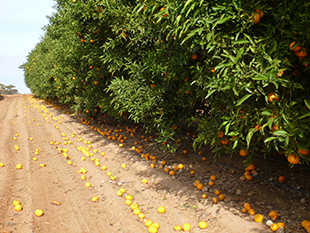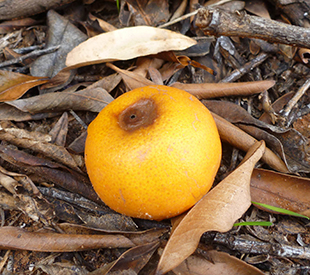
Black core rot in mandarins

There has been excessive fruit drop in southern growing regions (pictured), particularly of Imperial mandarins. The likely culprit is black core rot caused by the fungus Alternaria alternata. Confirmatory testing is in progress through the NSW DPI Plant Health Diagnostic Service (PHDS).
The fungus needs an entry point into the fruit, either through the navel, cracks or through wounds. The Alternaria then grows into the core of the fruit. Fruit can also develop a brown–black lesion at the basal end (pictured below). Affected fruit often colour early. Mealy bug infestations can exacerbate problems with black core rot.
Published recommendations are to delay harvest to allow time for affected fruit to fall from the tree. Much of the affected fruit has now fallen this season, although pieces can still be found on the trees.
Affected fruit, even with a small infection, can have significant off-flavour that can negatively affect customer satisfaction. Black rotted tissue also ruins juice appearance.Growers are recommended to delay harvest as long as is practical and to train pickers to quickly shake the branch prior to harvest.
To avoid fruit infected with black core rot or other pathogens such as Phytophthora ending up in the packing shed, it is critical that pickers do not pick up fruit from the ground. Also do not put fruit in the bins with missing buttons as these fruit could be infected.
Growers have reported an increase in black core rot in recent years. Changing seasonal conditions might be to blame. NSW DPI is currently collating technical information from relevant experts and in the next issue of CitrusConnect will provide information on management options before flowering.


